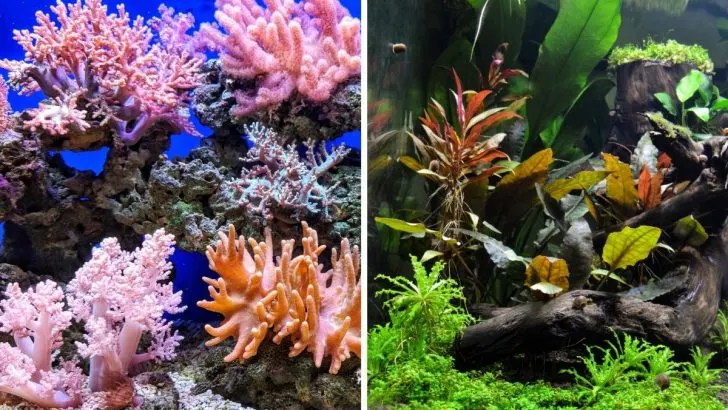In today’s article, we will talk about 15 underwater flowers. These beautiful plants will beautify your home with their wonderful colors of flowers and leaves in your home transparent aquariums.
Not everyone decides to take this step of growing plants. Cultivation is not that simple. Because they require much more adaptation, care, and care than ordinary house plants in pots that we are used to.
However, once you’ve made up your mind, you’ll be more than happy that you chose to grow them in your home. Aquatic plants will definitely be the envy of everyone who visits you.
Let’s find out more about what the aquatic world has to offer and which one to choose for your home.
Types Of Water Plants And Underwater Flowers
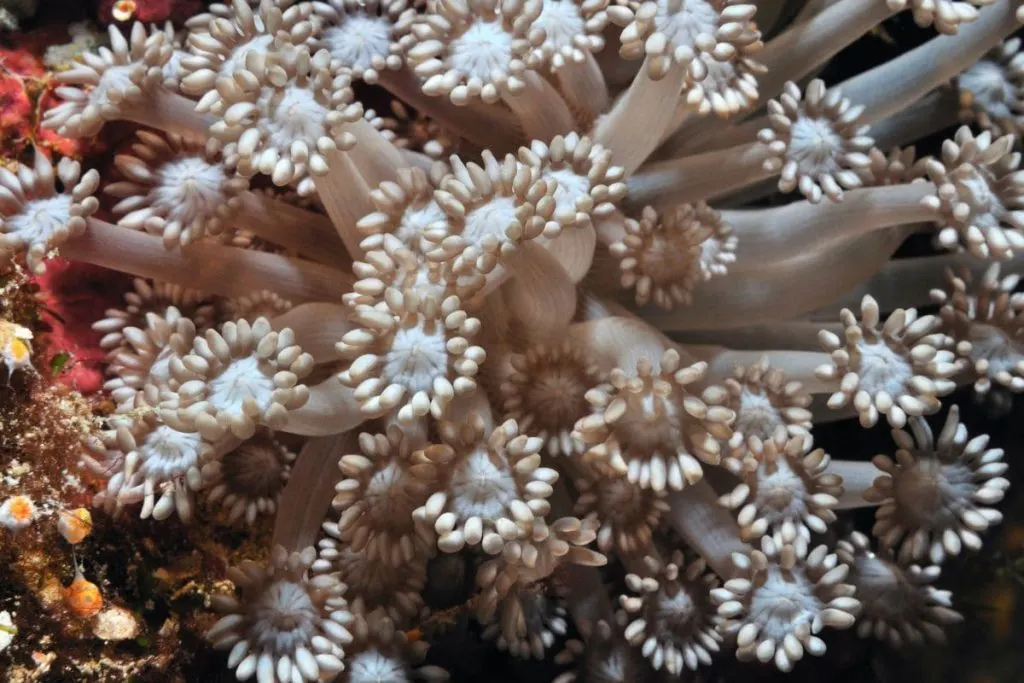
The flora that lives in the reservoir serves not only as decoration. It acts as a natural filter, absorbing organic residues and bacteria. It maintains the purity and transparency of water and oxygen saturation.
You can distinguish several groups:
- deep sea;
- floating;
- coastal and moisture-loving;
- oxygenators or purifiers.
When choosing plants, you must take into account the location of the reservoir and its lighting. Many ornamental aquatic species need 5-6 hours of direct sunlight per day to grow and bloom. Some species do well in more shaded areas.
Care Guide And Detail Features Of 15 Water Plants And Underwater Flowers
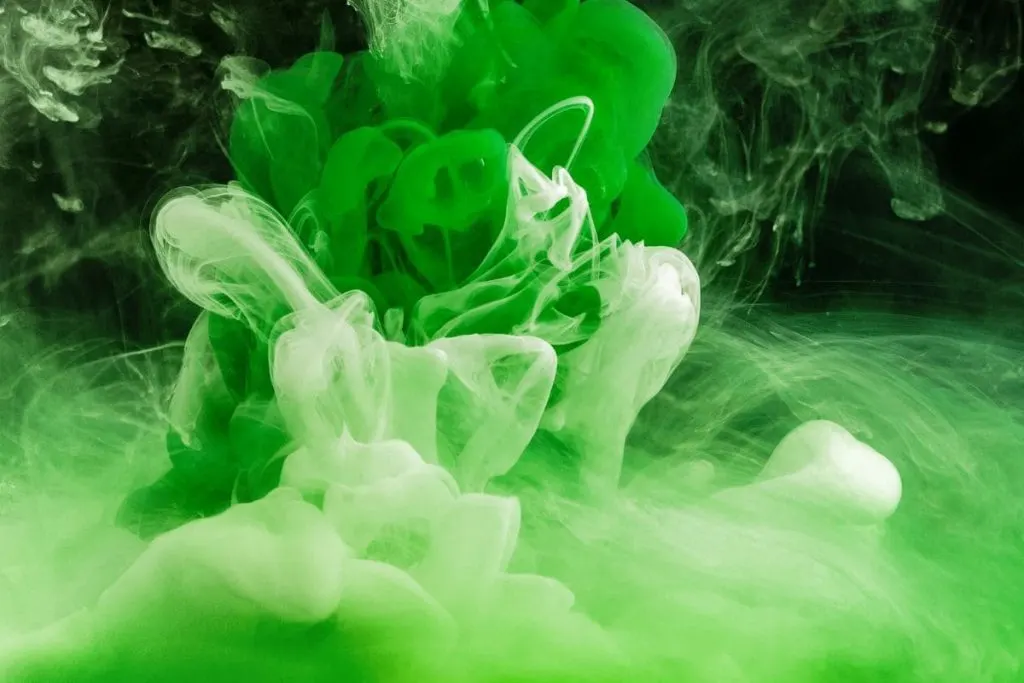
Below we have prepared 15 beautiful plants that you will fall in love with! The specialty of these plants is in their appearance, a different way of growing, and definitely colors.
Colors that do not look like ordinary shades of yellow, red, purple, and other colors that we see every day. We have also more information on other colorful houseplants.
Some of the mentioned plants will be completely in the water, and some will have their flower above the water, but either way, you will love each of them.
Their bottom is very unique and it is visible in their physical appearance. Let’s find out how these plants grow, and then try them and enjoy the presence of these plants in your home.
1. Carnivore Underwater Plants – Tufted Fast Growing Plant
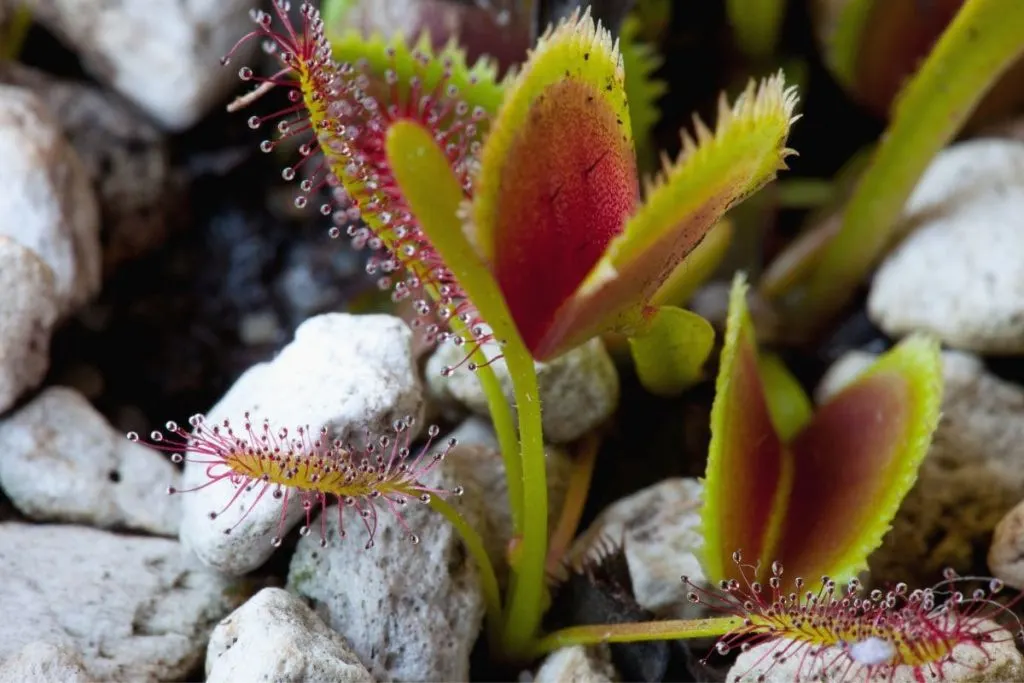
– Some plants do not go out into the air at all. These submerged plants are underwater all the time, except during flowering. Then flower stalks with flowers grow outside their surface.
– Some have completely changed their appearance and look more like algae than real plants. They consist of long stems on which short threadlike leaflets grow.
– The plant needs 6 or 7 hours of direct light. It doesn’t need to be fertilized at all as long as it has enough light. You can propagate them vegetatively and with stem cuttings.
– The roots of these plants often die and they don’t even need them – they absorb gases for breathing and water and minerals with their leaves and stems. While crocus and waxwort are rooted, Utricularia Vulgaris lives freely in the water.
2. Lotus Plants We All Know And Love
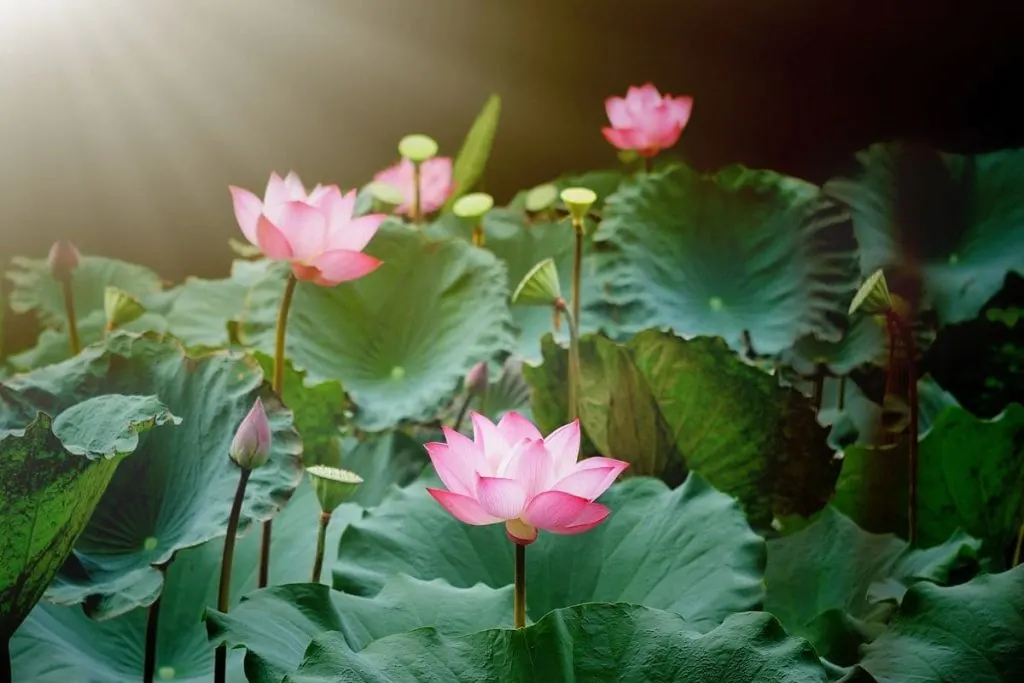
– The lotus is an incredibly beautiful amphibian herbaceous plant that can grow for several years thanks to its massive roots in which it accumulates nutrients.
– The lotus owes its popularity to its large cream, yellow or pink flowers. Lotus can propagate by both seeds and rhizomes.
– Moreover, in the second case, the lotus may bloom the following season. When planting a lotus, you should keep in mind that this flower likes clean water.
– It is better to sprinkle the bottom of the reservoir with small pebbles and do not forget to periodically clean the water. In the spring, if the lotus has grown, it should be cut off, first of all, remove old and dying flowers and leaves.
3. Water Lilies – Aquatic Plant You’ll Adore In Your Planted Tank
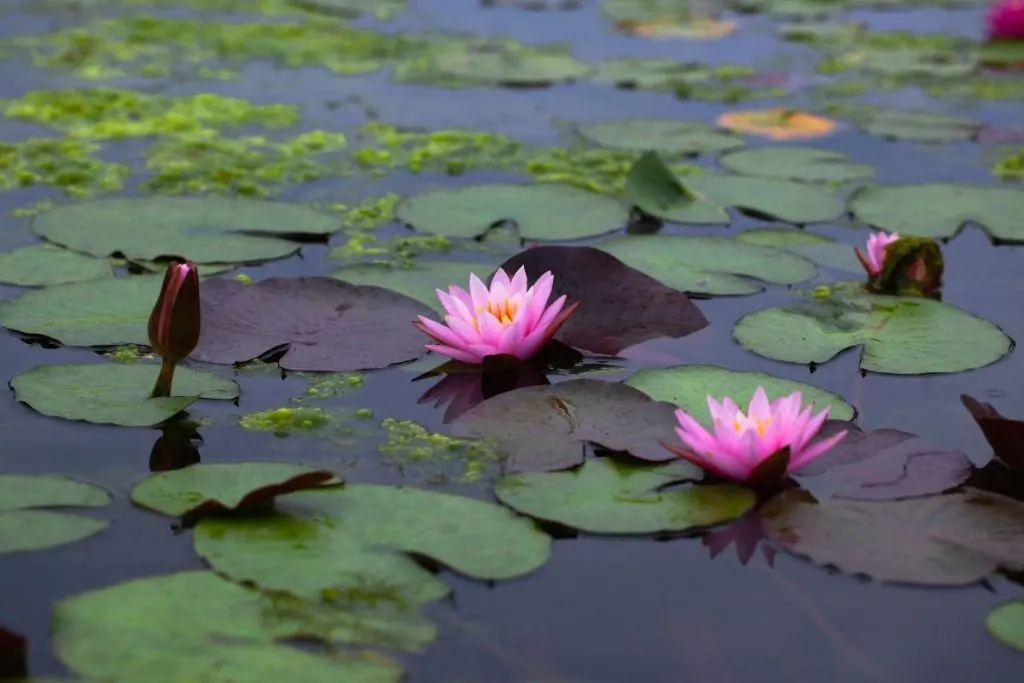
– A water lily is a floating plant. It has often the name “water queen” because it is one of the most beautiful and largest flowers in our region. These plants belong to the water lily genus, or nymphaeum, which has about 40 plant species.
– Lokochi is a remarkable plant in many ways, especially with its white flowers. These flowers live in very warm and icy water bodies and are distributed almost everywhere: from the forest-tundra to the southern tip of the American continent.
– Water lilies need 8 to 9 hours of direct sunlight. They propagate vegetatively, and their propagation is very easy, even a beginner can do it. You can also propagate them by dividing the underground stem. Use 10-14-8 fertilizer in the springtime. Use distilled cold water for them.
– It is an interesting fact that water lilies rise to the surface of the water strictly at six in the morning, open their blooms and close strictly at six in the evening and go underwater again. For anglers, the lack of water lily flowers on the surface is a very visible sign of changing weather.
4. Duckweed – Aquatic Flowering Plants From Pacific Ocean In Your Living Room
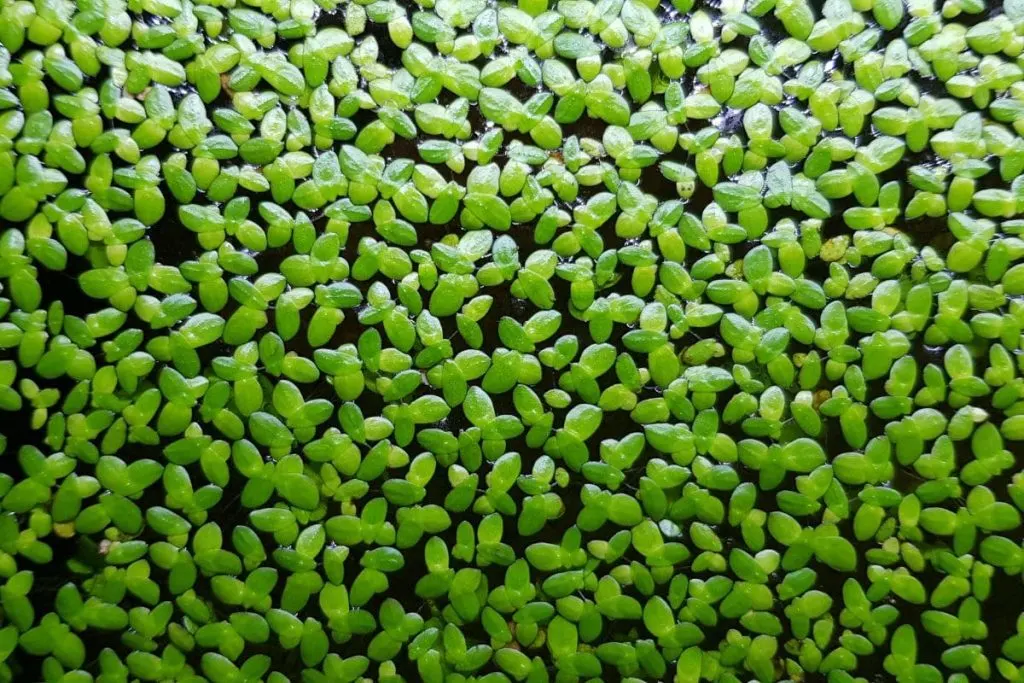
– Duckweed needs no special introduction. Everyone who was near lakes, ponds, or old ditches with water in the summer saw this plant, which covered the surface of the water with a thick emerald carpet. Several species of ducks, which are members of the duck family, are distributed throughout the world, including Russia.
– These are small plants that float on the surface or in the water column, and consist of leaves – leafy stems, joined together in several pieces, from which one short thread-shaped root extends. In natural reservoirs, duckweeds rarely bloom.
– In the warm period, the plant reproduces vegetatively, with the help of young leaves that separate from the parent plant.
– Duckweed overwinters in the form of buds, which sink to the bottom along with the dead plant. They prefer the same fertilizer as lotus plants: 10-14-8 fertilizer and just love from 5 to 7 hours of bright indirect light.
5. Shinnersia Rivularis And Its Amazing Green Bushy Features
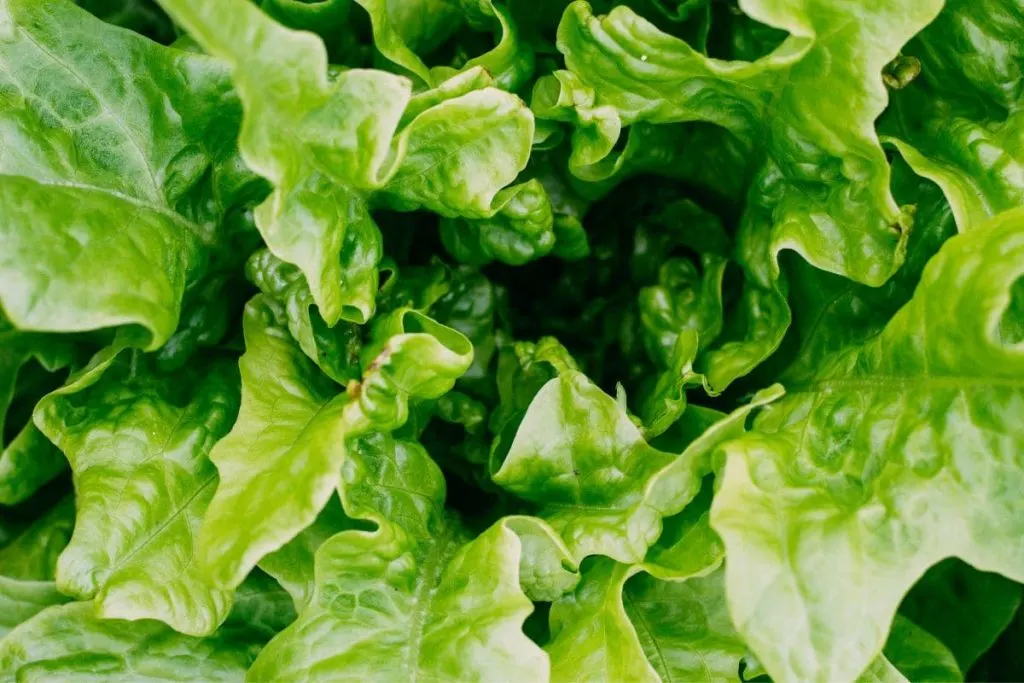
– In their native habitat they live in rocky rivers in Mexico. A very unpretentious plant, it can be planted in the ground, to which it is undemanding, or left to float. When growing the floating form, the trichocornis leaves become smaller.
– It can grow in hard and alkaline water. It has a well-developed fibrous root system. Green carved leaves vary widely in shape and size, depending on conditions.
– The required lighting is moderate to strong. In a low aquarium, the plant branches, after they have come to the surface, come out of the water, so their tips must be pinched. It reproduces by basal or side shoots from leaf buds.
6. Water Salad Plants – Greenish Flowering Aquatic Plants
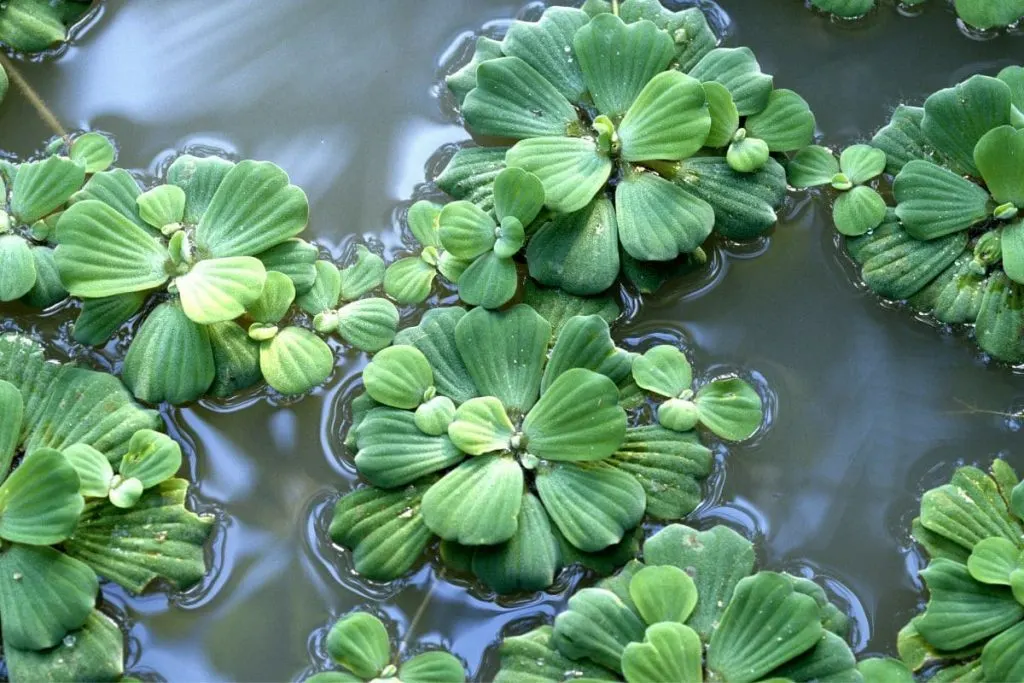
– Aroid family, common in water bodies of tropical and subtropical regions. It’s a herbaceous plant, that floats on the surface of the water. It has a well-developed root system, consisting of many long white roots, reaching a length of 11 inches.
– The leaves are bluntly wedge-shaped, up to 13 inches long and wide. They have a spongy structure with cavities filled with air, thanks to which the plant lies on the surface of the water.
– Pistia roots serve as a substrate for spawning fish and a refuge for their young. The aquarium with the pistia should be under glass and well-lit from above. Blooms in good condition in summer. The flower is a green blanket and a small spike. They prefer dry fertilizer in their growing media.
7. Heteranthera Zosteraefolia – More Flowering Aquarium Plants For Your Cottage Pond
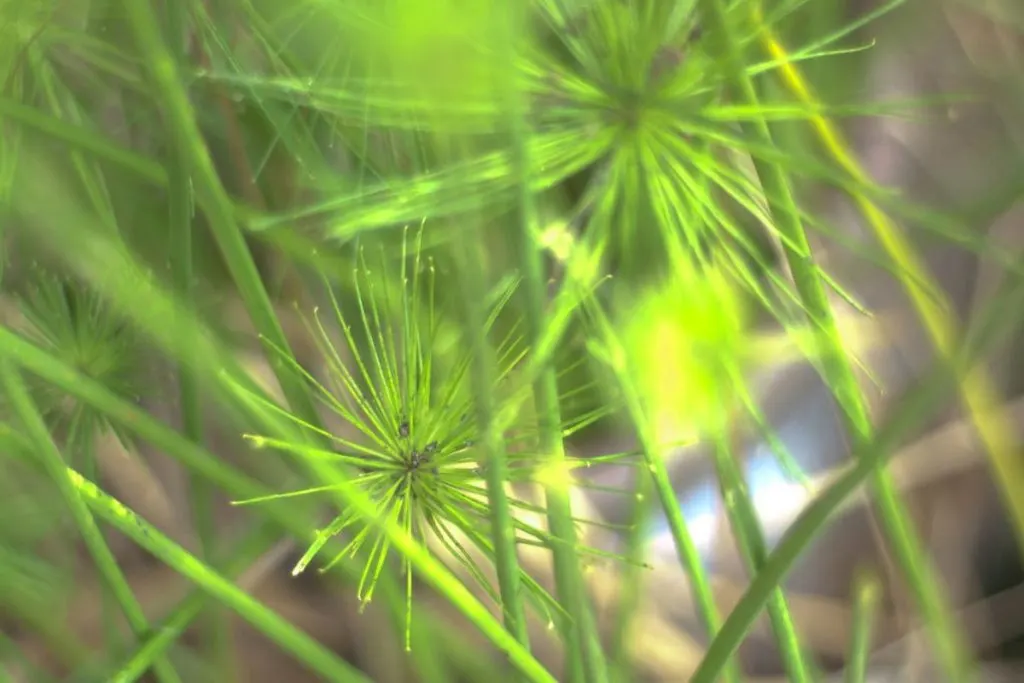
– A floating plant with a poorly developed root system, thin white roots, and pale green or green leaves up to 3 inches long. Widespread in slow-flowing and stagnant reservoirs of tropical Africa.
– It prefers clay soil and soft water with temperatures above 45 F as well as bright diffused light. The plant develops better with a low water level. Propagation is by the stem and root cuttings. Place them somewhere where they can receive lots of direct sun.
– Coliform with bluntly pointed leaves and kidney heteranther with denser heart-shaped leaves are also grown in aquariums. These so-called flowers actually don’t produce flowers but you’ll enjoy the view anyway.
8. Myriophyllum Flowering Plant And Its Aquatic Underwater Flowers
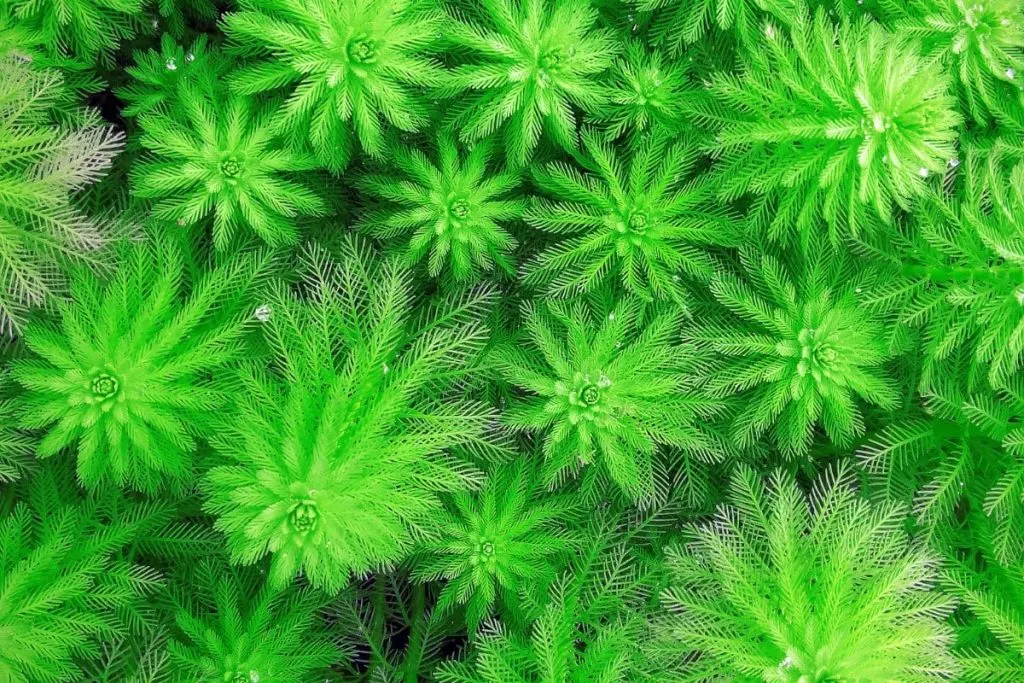
– Homeland – North America. Translated from Greek, Myriophyllum means “many leaves.” Pinnate leaves have forked leaves split into many filiform segments. These are very picturesque plants that live in water.
– On their bright green branching shoots are countless thin, delicately cut dark green leaves. Peristoliths thrive in sandy soil, soft water with a temperature of about 55 F, and strong diffused lighting. They don’t need fertilization.
– Unpretentiousness and fast growth have made cinnafolia one of the main plants for decorating an aquarium and an excellent substrate for fish spawning. All plants have similar conditions for keeping and growing. Propagation is by cuttings.
9. Brazilian Feather Leaf As One Of The Best Aquatic Underwater Flowers
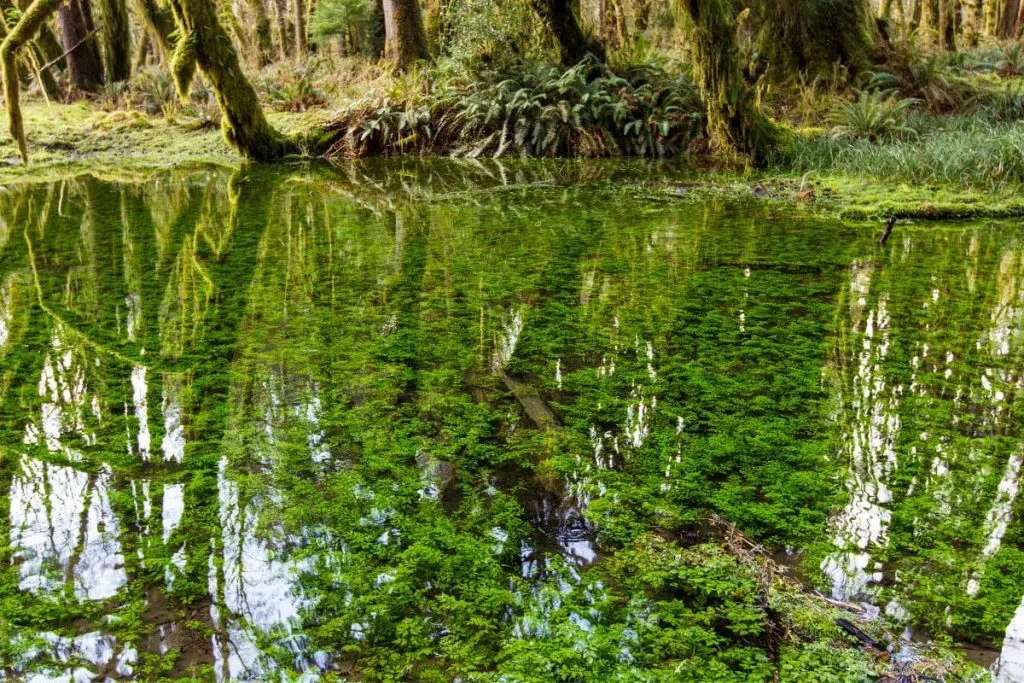
– Brazilian feather leaf is common in Brazil. At a water temperature 50-55 F and strong diffuse lighting, it develops quickly.
– Propagation is very easy. Just place the bare roots in the water and voila, you’re done!
– When it reaches the surface, the sapling is pinched for more lush branching. As for the soil, a mixture of peat, leafy soil, and sand is suitable.
– The plant does not tolerate hard salt water. It is propagated by root shoots and cuttings, which take root at low water levels in clean river sand.
10. Lilac-Looking Purple Coral
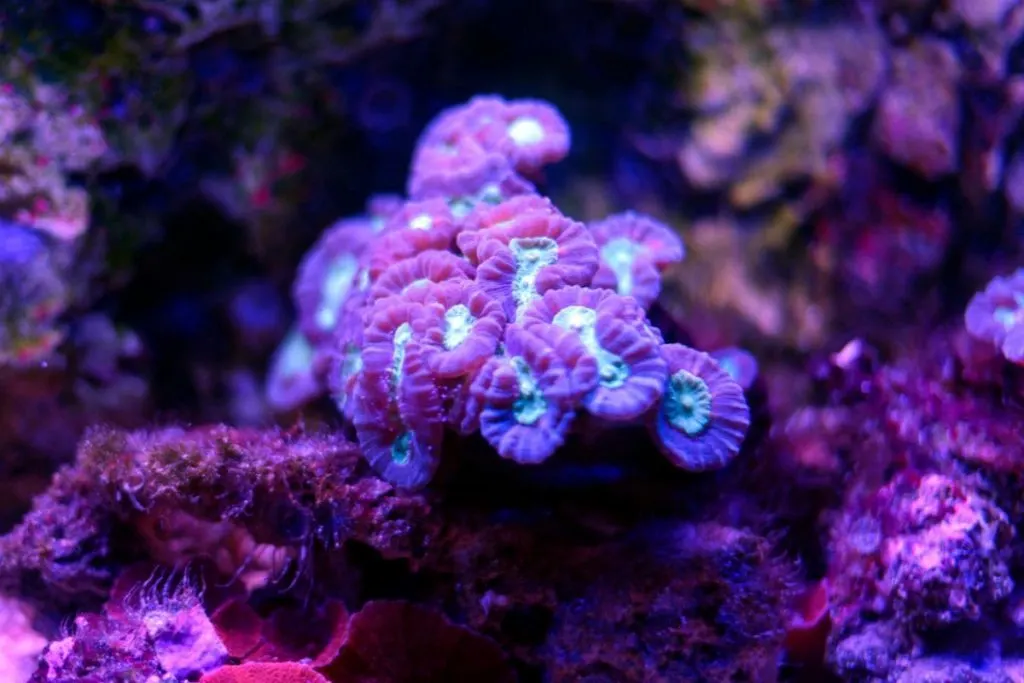
– Corals are marine organisms that belong to the Anthozoa family, this family of invertebrates also includes sea urchins and jellyfish, the whole family has over 6,000 species, of which only corals have over 2,500. Until the 18th century, corals were thought to be plants, with the advent of the microscope every dilemma was resolved.
– Coral is a colony of identical multicellular organisms called polyps, they can be from a few millimeters in diameter to several centimeters in length.
– The individual polyp is radially symmetrical and has a tubular body with tentacles around the mouth at the upper end of the body. A colony of several hundred to several thousand polyps constitutes a coral.
– Corals reproduce sexually or asexually, i.e. by internal or external fertilization. With internal fertilization, the coral will fertilize itself, that is, each polyp is a hermaphrodite, while with external fertilization, one coral releases eggs, and the other sperm, and fertilization takes place in the open sea. The fertilized egg will develop into a polyp in a period of 1 day to several weeks.
11. Underwater Flowers Grow On Amazing Anubias Plants
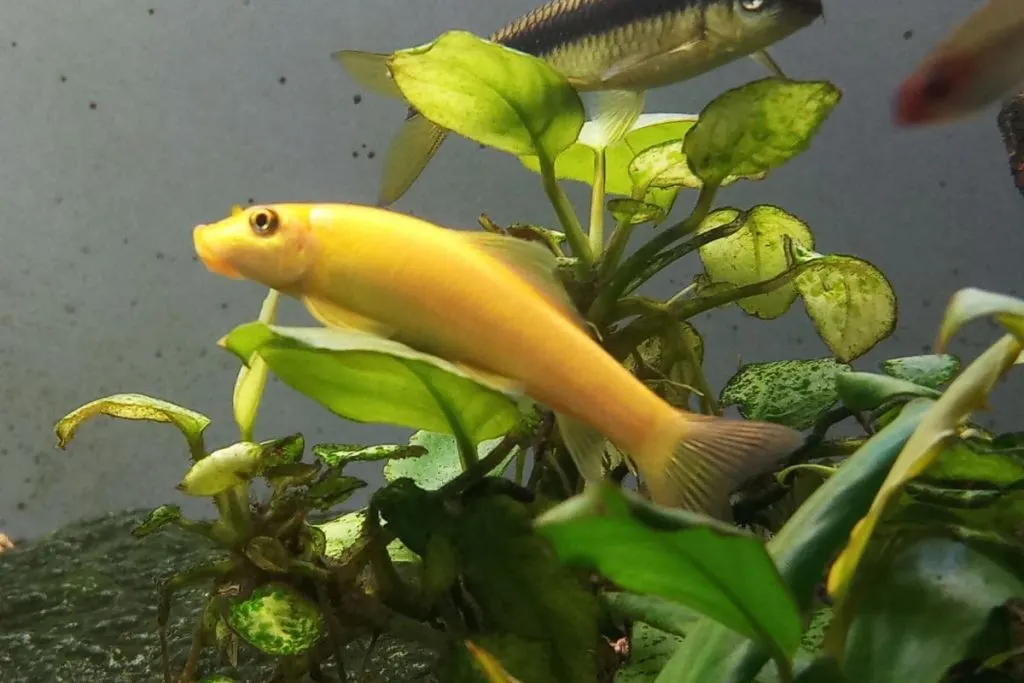
– A beautiful hard-leaved plant, in the middle or back part of the aquarium, suitable for cold and warm water aquariums. It is slow-growing and more light-demanding than other Anubias species.
– We can speed up growth by cutting off old leaves, and thus we will avoid the formation of algae on them. It succeeds best tied to a stone or stump, if it is planted in a substrate, its rhizome must always be above the surface of the substrate.
– This plant, like other Anubias species, is propagated by dividing the rhizome. Although the plant thrives in an aquarium after adaptation, the best cultivation results will be achieved by partial planting in water, which requires a loose substrate rich in iron.
12. Amazon Sword Plants For Your Home Aquarium
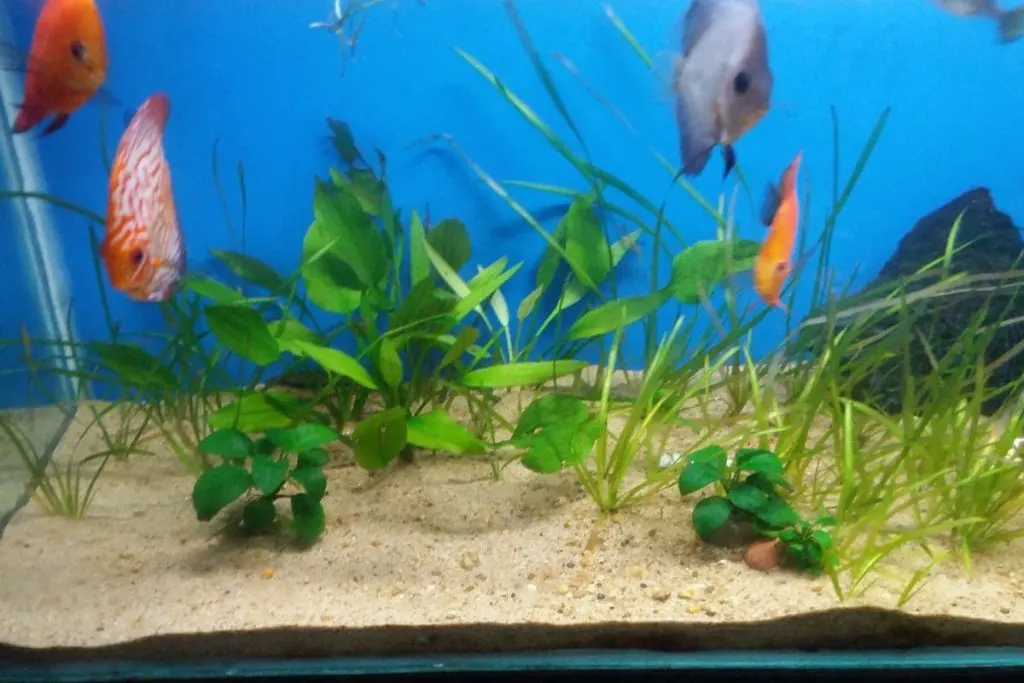
– The Amazon Sword plant is by far one of the most popular types of aquarium plants among freshwater hobbyists. These plants require only a moderate level of care and grow well in moderate to bright lighting. As is the case with most aquarium plants, Amazon Swords need about 10 to 12 hours of full-spectrum lighting per day.
– For best growth, provide them between 2 and 4 hours of lighting per gallon – this will vary depending on the size and variety of your aquarium.
– In addition to lighting, Amazon swords also require certain nutrients in the water tank. These plants grow best in a loose substrate that offers plenty of iron supplements.
– Your Amazon Swords will draw most of their nutrients from the water tank, but a nutrient-rich substrate will help maintain healthy growth.
13. Bucephalandra Plant For You Indoor Aquarium
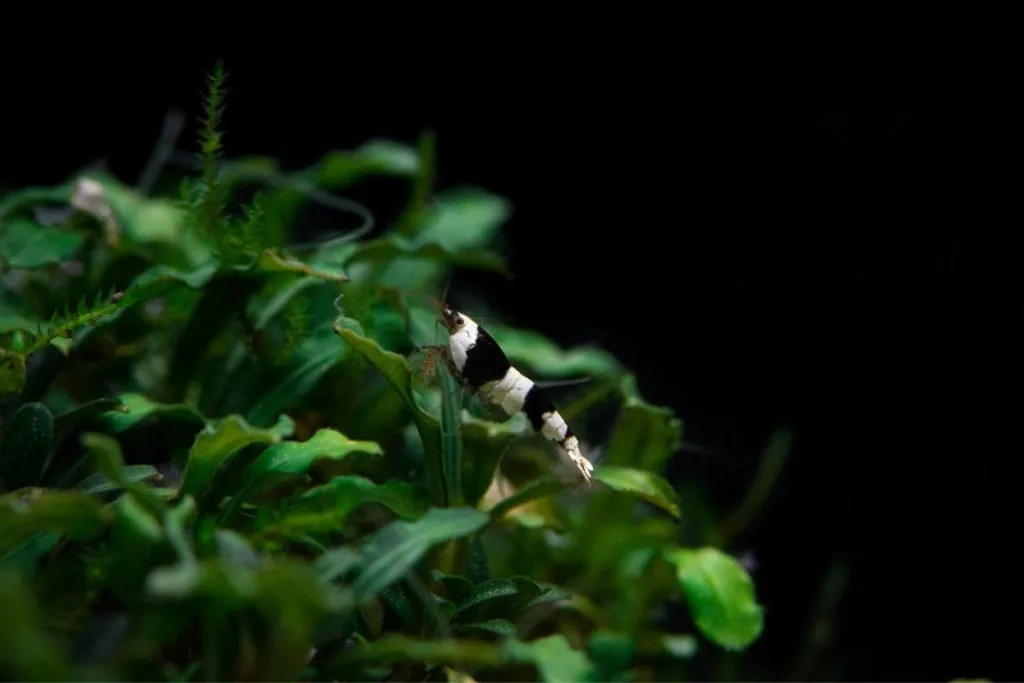
– When you decide to plant a new plant, don’t neglect the quarantine measures you need to take as well. In such conditions, various parasites will drown. After that, you can move on to the adjustment phase.
– The plant is placed in a greenhouse, and treated with “Epin” or “Fitosporin”. Quarantine lasts 40 days. After this time, the specimen is ready to be planted in the aquarium.
– All types of bucephalandra have a strong root system since in nature the plant develops with strong water movement. So, the culture itself is attached to the soil, and when it is planted in the aquarium, it can simply be tied to a stone or a nail.
– If the shoot is planted in the ground, the aquarist must take care of its nutrition in advance. Some experts still advise first planting it in the ground in order to get a powerful, well-developed root system and to reliably strengthen it in the future.
14. Cabomba Plant Thrive In Your Home Aquarium Too As Underwater Flowers
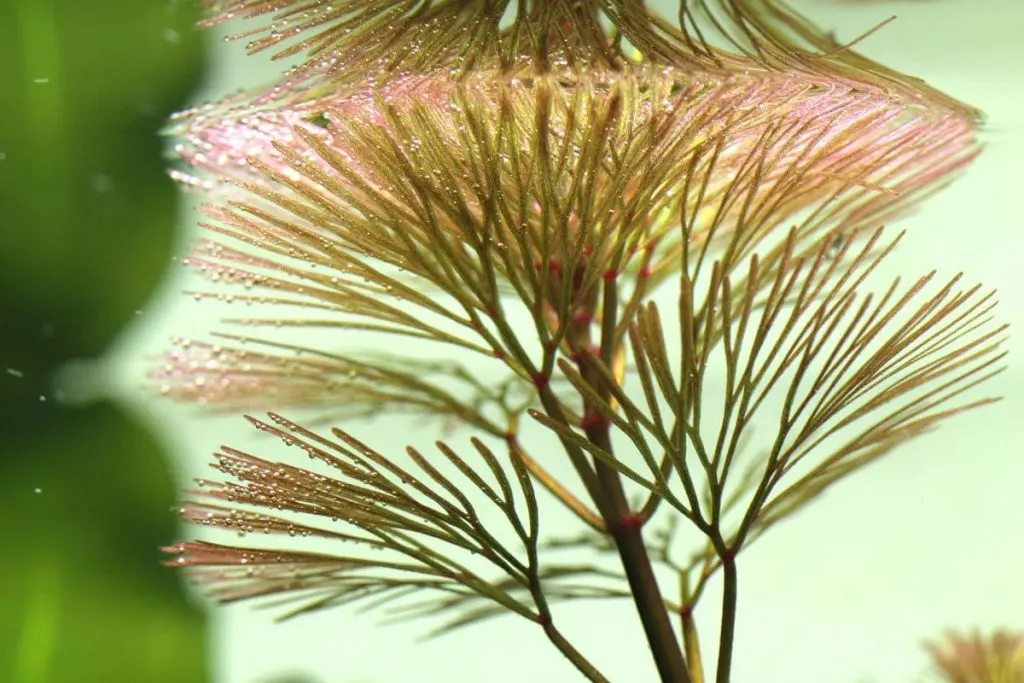
– Unfortunately, this plant is quite demanding, so it is not suitable for wider circles of aquarists. First of all, it requires a lot of light, and preferably slightly acidic and soft water.
– Also, the water must be crystal clear, otherwise, impurities and particles from the water will remain on the leaves. It is mandatory to add microelements in the form of liquid fertilizer.
– It can be propagated very simply like other species from the genus Cabomba; by cutting and replanting the upper part of the stem of the parent plant, we will not only get a new plant but also the parent plant will take on a bushier shape thanks to the formation of side branches.
– In suitable conditions, this plant grows very quickly, so it requires regular trimming and maintenance. Cabomba Aquatica is a large plant that will grow until it reaches the surface of the water.
– Then, completely different, round leaves will form on the surface, between which small yellow flowers will develop. I would recommend this species to anyone who can provide it with adequate conditions – you won’t regret it.
15. Sagittaria Plants As One Of The Slow Growing Plant For Home Aquarium
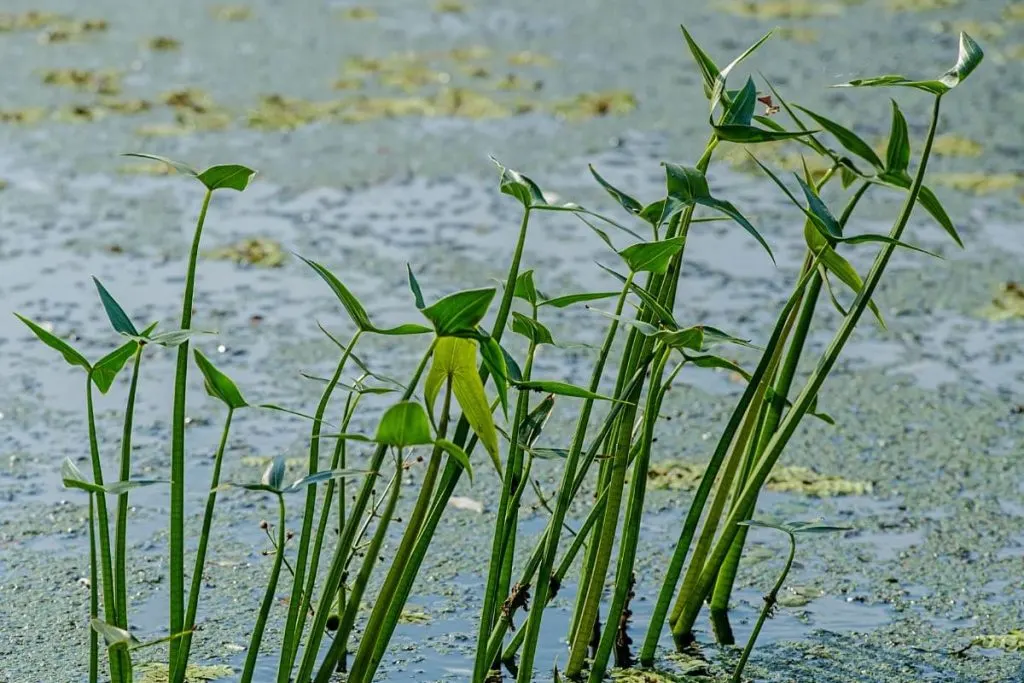
– Sagittaria belongs to the group of less demanding plants that are ideal for planting in the foreground of the aquarium. However, this plant is also suitable for decorating the background of the aquarium or its sides.
– Its natural habitat is South America, and for successful growth and cultivation, it needs stronger light intensity and harder water with a temperature range of 55-60 F.
– Sagittaria subulata is characterized by its saber-shaped leaves that can sometimes reach 28 inches in height, and in ideal conditions, your aquarium can be decorated with small white flowers that show on the surface of the water.
– It reproduces independently and is highly recommended for all beginners in the world of aquarists. It comes from South America, is not demanding, and spreads and reproduces very quickly.
Importance Of Flowering Plants In Water For Water World And Underwater Flowers
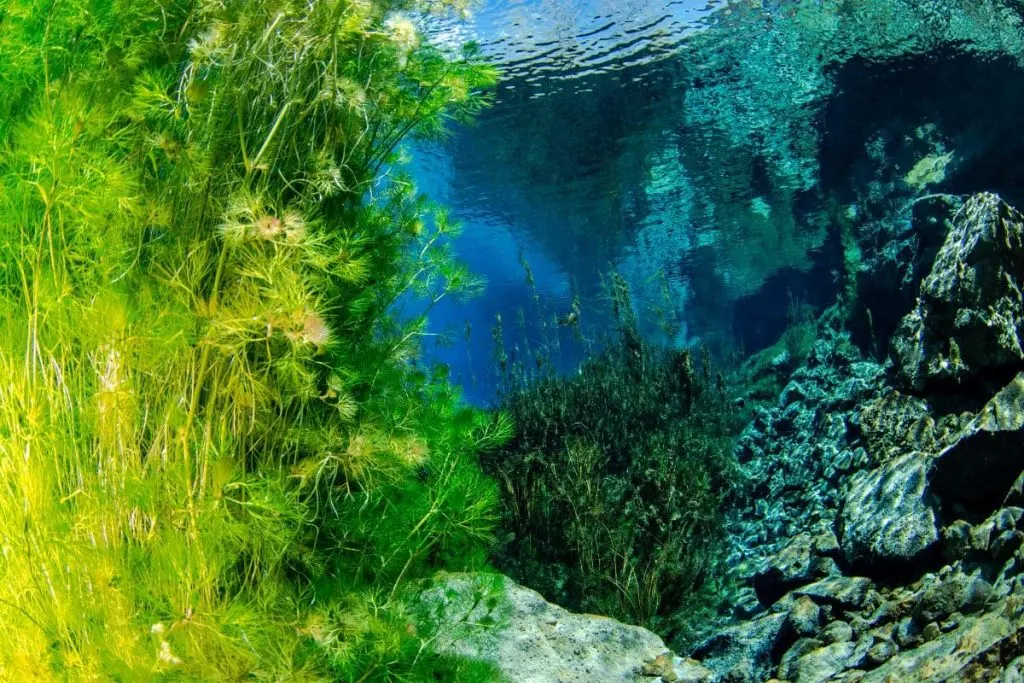
We have to take into account our climate because in winter the amount of vegetation in many water bodies decreases sharply and the fish have to switch to other types of food. We call such fish facultative phytophages.
Only by this criterion of food can a certain picture of the underwater inhabitants be made. When you find planktonic algae in large numbers, then look for fathead minnows, the same cockroach, and other cyprinids and Pacific sardines.
In some regions, well-developed higher aquatic vegetation makes it possible to locate grass carp and robins.
It is very interesting that there are much fewer phytophagous among marine fish. fish than freshwater, although very nutritious and tasty algae grow in large quantities in the sea, which is often included in artificial food when breeding many species of fish.
History Of Water Plants And Underwater Flowers
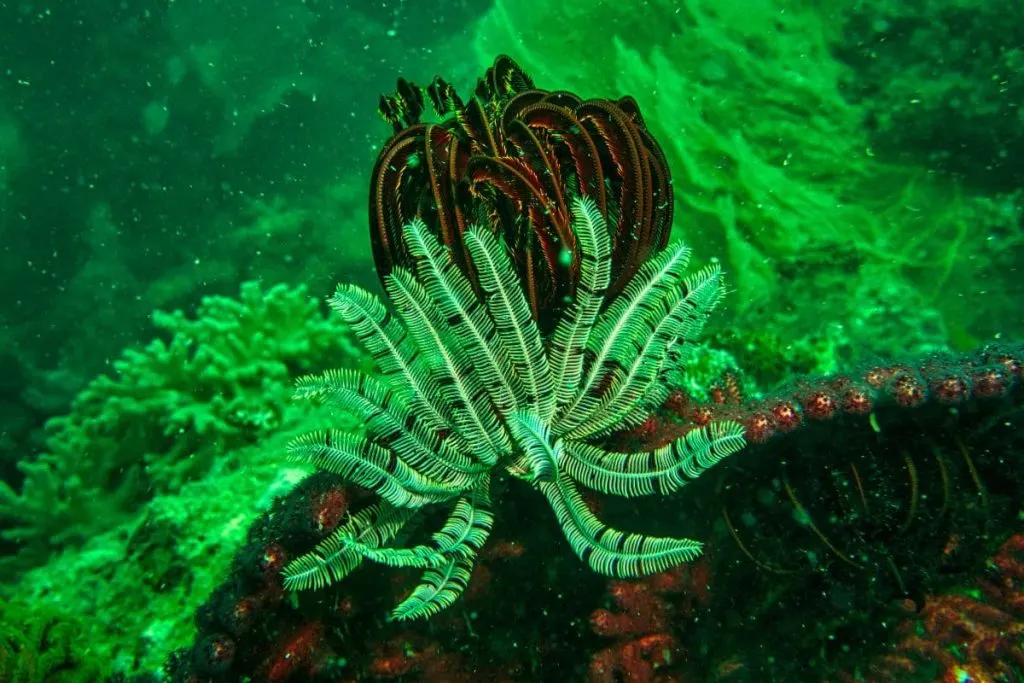
Water gardens and water features in general have been part of public and private gardens since ancient Persian gardens and Chinese gardens. For example, the Nanfang Caomu Zhuang records the cultivation of Chinese spinach in floating gardens.
Water features were present and well represented in every period and in every culture that incorporated gardens into their landscapes and architectural environments. When the modern water pump was introduced, water was not recirculated, but diverted from rivers and springs into a water garden, from which it exited to agricultural fields or natural watercourses.
Historically, water features have been used to enable the production of plants and fish, both for food purposes and for decorative aesthetics. When aquatic flora and fauna are balanced, an aquatic ecosystem is created that will support sustainable water quality and clarity.
Elements such as fountains, statuary, artificial waterfalls, rock formations, underwater lighting, paneling treatments, edge detailing, watercourses, and in-water and waterfront plantings can add visual interest and help integrate the water garden with the local landscape and environment.
Final Thought On Underwater Flowers
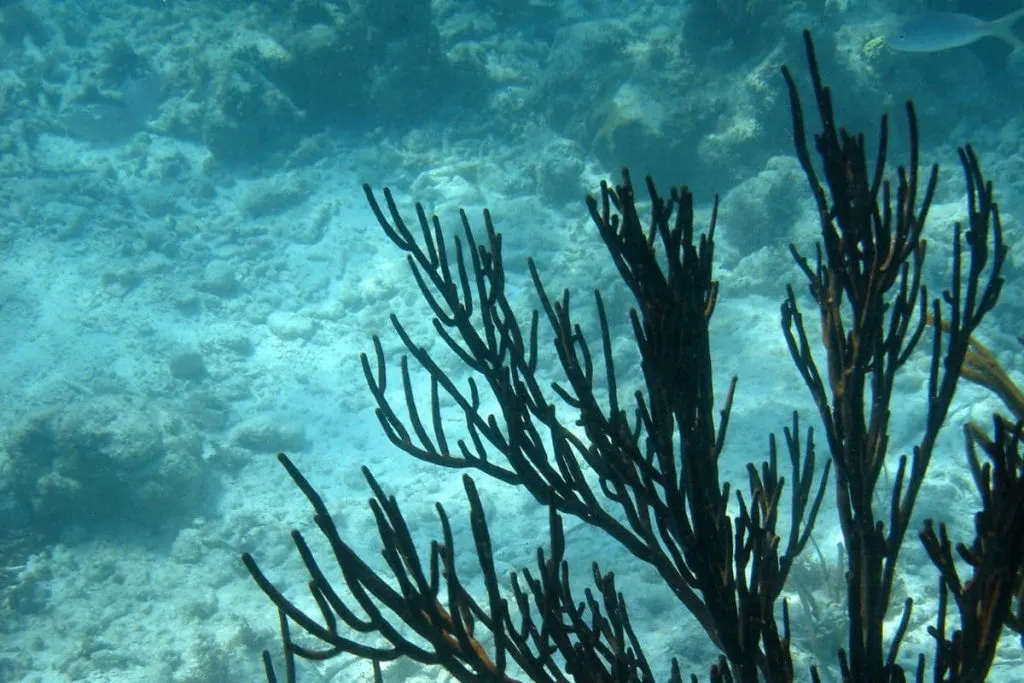
In today’s article, we learned about the importance of aquatic plants, and we learned a little more about the 15 most beautiful species of underwater flowers.
If before this article you were in doubt about whether to get them for your lady, I’m sure that all doubts have disappeared, right?
Only photos were enough, I’m sure you can look at all the wonderful colors that the aquatic world offers when it comes to plants. it’s no wonder why we all loved diving as children, the aquatic world offers so much beauty.
Some plants are more demanding, some are really easy, so find the one that best suits your style and speed of life.
That would be all for today, see you soon with more similar articles! Thank you for your trust.

